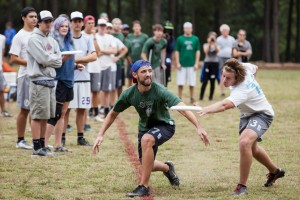
Rules to Bid By
By Jack Curran
Following up on Ultiworld’s article on four widely misunderstood rules in ultimate, we tapped local observer veteran, the ever humble Jack Curran, to get his take on some of the rules he gets questioned about the most. Here’s the first of many installments of Rules to Bid By.
Ultiworld posted an article, with the assistance of the national observer director, Mitch Dengler, that covers four commonly mistaken rules in ultimate. I highly recommend checking it out, as it’s your responsibility to know the rules. I’ll wait while you go back and read it… Ok, now that you’re back, there are some more rules that you should know better than you probably do.
As Atlanta’s best (looking) observer, I encounter a few fuzzy interpretations of the rules on a regular basis between league and club play. In a few different entries I’ll go over a few of those, and hopefully we’ll all get them right next time!
Picks and the Continuation Rule
 Picks are the most common call in league play given the lack of well oiled offenses. The Ultiworld article covers what a pick is, and how players should set back up, but I frequently see confusion when trying to apply the continuation rule when deciding where the disc should end up.
Picks are the most common call in league play given the lack of well oiled offenses. The Ultiworld article covers what a pick is, and how players should set back up, but I frequently see confusion when trying to apply the continuation rule when deciding where the disc should end up.
Let’s set up a scenario:
Lindsay has the disc and throws to an in-cutting Jacob. After Lindsay releases the disc, Defender 1, who is covering Dan on the opposite side of the field calls a pick. Jacob catches the disc, looks up field, and throws to Natalie who is wide open in the end zone, but throws it wide, and it hits the ground.
We know that the pick on Dan did not affect the play, but where should this disc end up? Is it a turnover? We have to consult the continuation rule.
In the 11th edition, the continuation rule states:
“Play stops when the thrower in possession acknowledges that an infraction has been called. If a call is made when the disc is in the air or the thrower is in the act of throwing, or if the thrower fails to acknowledge the call and subsequently attempts a pass, play continues until the outcome of that pass is determined.”
Then, as it relates to a pick:
- If the team that committed the infraction has possession:
- If the infraction affected the play, play stops and the disc reverts to the thrower unless the specific rule says otherwise.
- If the infraction did not affect the play, play stops and the result of the play stands.
Because the pick did not affect the play, we know that one of these throws should stand: the throw from Lindsay to Jacob. However, that is as far as the continuation rule can move the disc because of the “play continues until the outcome of that pass is determined” clause. Once Jacob catches the disc, play stops no matter what he does with the disc. If he turns it over or completes a pass, the disc will come back to him.
The easy way that I think of the continuation rule is it can only continue play until one catch. Once anyone catches the disc, play stops. So in our scenario, the disc should end up with Jacob, all players should return to the space they occupied when Jacob caught the disc, and it’s like he never threw it to Natalie in the first place!
Next entry, I’ll cover fouls away from the disc and how to apply the continuation rule again!

